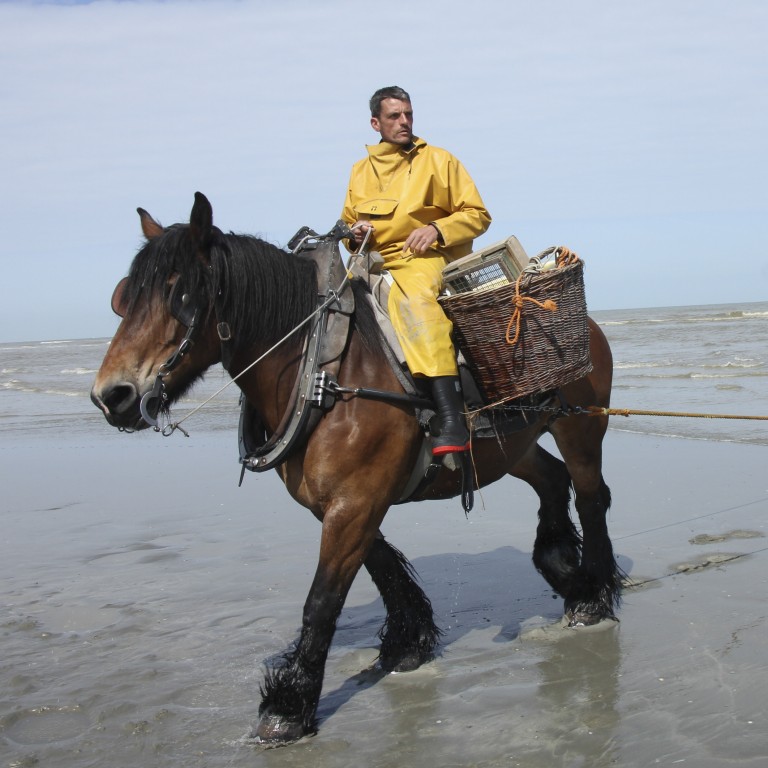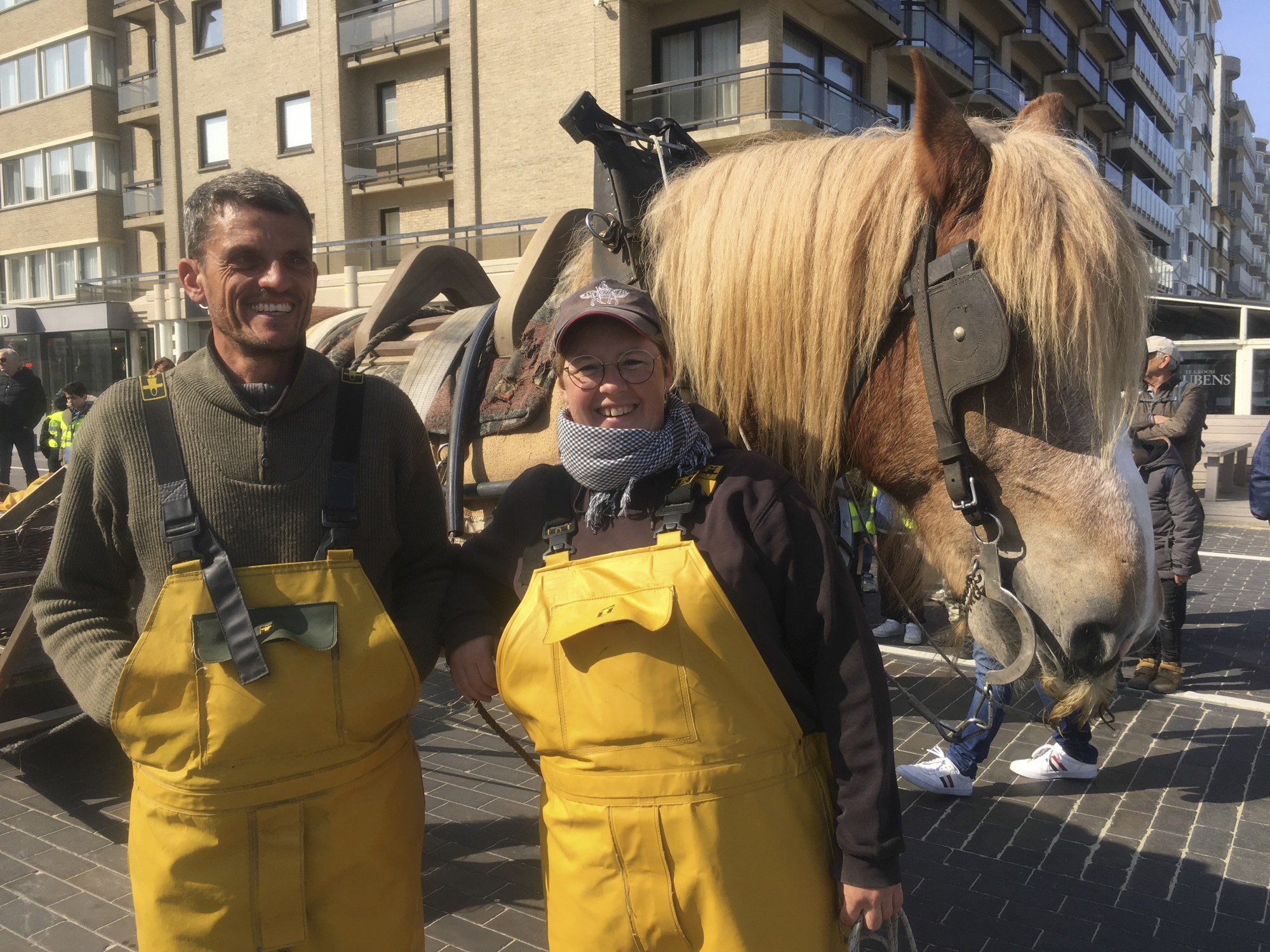
Unesco intangible cultural heritage: horse-riding shrimp fishermen of Belgium who are the last of their kind
- The Belgian beach resort of Oostduinkerke is the last place where shrimp fishing on horseback is practised - and the spectacle is a sight to behold
- Visitors curious to see how the shrimp taste often tuck in at a tavern owned by a shrimper family, opposite a fisheries museum, and a brewery on the coast
The Belgian beach resort of Oostduinkerke resembles a Victorian seaside postcard, with striped windbreakers, sunbathers snoozing in deckchairs outside retro bathing huts, children building sandcastles, and families playing mini-golf.
But this is also the last place in the world where the tradition of shrimp fishing on horseback is practised.
All activity suddenly stops when a parade of half-a-dozen giant Brabant dray horses appears, pulling rickety carts as they trot across the sand towards the sea, with each of the one-tonne beasts accompanied by a rider clad in bright yellow oilskins.
These are the paardenvissers, Flemish horseback fishermen who have practised their profession for more than 500 years, their predecessors having operated along the whole of the North Sea coastline, from Germany down to France.

The last survivors are here in Oostduinkerke and were recognised in 2013 by Unesco as intangible cultural heritage.
These 16 fishermen and their massive horses are supported financially by the local municipality, allowing them to pass on and share with visitors this unique practice.
From April to October, they make regular sorties into the low-tide waters of the North Sea, attracting crowds of fascinated holidaymakers enjoying the spectacle free of charge.
Collector’s private sex doll museum the ‘deepest cult spot in Japan’
Belgium may not be an obvious seaside holiday destination. But its 60km (37 miles) of golden beaches and wild sand dunes, stretching between the French and Dutch borders, are becoming an increasingly popular alternative to the sun-drenched resorts on the Mediterranean and Adriatic as more holidaymakers are searching out literally cooler destinations in which to avoid the soaring temperatures and growing wildfires of Southern Europe.
Environmentally responsible tourists are further encouraged to visit by the presence of the hop-on, hop-off electric Coastal Tram, which runs between De Panne and Knokke-Heist – a ride of 153 minutes in total – meaning there’s no need to rent a car.
While many of the coast’s old-fashioned bathing stations, such as Blankenberge and Le Coq-sur-Mer, are perfect for family trips, cosmopolitan Ostend has become a fashionable cultural centre for art and music, while chic Knokke boasts both Michelin-star restaurants and a wetlands reserve, the Zwin Nature Park.

However, nothing compares to the experience awaiting intrepid travellers who have checked with the low-tide timetable – displayed on the websites of the local tourism office and Belgium’s National Fisheries Museum, also called Navigo, which is located in Oostduinkerke – and arrived in time to witness the paardenvissers riding their massive steeds through the main streets of the town to a flat, 1km stretch of beach.
At the water’s edge, the fishermen quickly rig two handmade wicker baskets on each side of their wooden saddle, then attach a long, funnel-shaped net behind the horse, which will drag up the sand and trap tiny grey shrimp, a highly prized ingredient in Belgian gastronomy.
The paardenvissers drag the shallow waters for around two hours, just before and after low tide.


The horses clearly love wading into the sea, and in a minute they are 20 metres out, the waves rising up above their haunches. They follow each other up and down the beach.
Horse and rider regularly emerge from the water, when the nets are emptied of a wriggling mass of shrimp, crabs and tiny fish. The shrimp are stashed in the wicker baskets, the rest of the catch thrown back into the sea or greedily devoured by swooping seagulls.

Horseback fishing was passed down from father to son for centuries, an exclusive all-male club, with the work deemed too physically demanding for women. But that all changed with Unesco recognition, which insists that its cultural heritage list must be equal opportunity.
Nele Bekaert immediately applied to enter the hallowed Royal Order of Horse Fishers, she tells me.
After the statutory two-year apprenticeship, passing theoretical and practical exams, she became the world’s first known female paardenvisser in 2015, proudly riding her 27-year-old dray, Axel, alongside her husband, Chris, a third-generation horse fisherman.

Oostduinkerke’s 16 official paardenvissers anchor a tight community, with each household specialising in a specific skill: net or basket weaving, equestrianism, knowledge of tides, currents and sand banks, and, of course, cooking the shrimp to perfection.
Although there is a ready market for each day’s catch among local restaurants, none of the paardenvissers could survive economically without a second job. Nele’s husband runs his own stables, Günther Vanbleu is a firefighter, Eddy d’Hulster owns a diner, while Katrien Terryn, who became the second official fisherwoman in 2020, works in a horse-riding centre.
After watching the unusual spectacle, obviously everyone wants to see how the shrimp taste.

While the paardenvissers take their catch home to peel and then boil them in bubbling vats of briny water, foodies head from the beach to Estaminet De Peerdevisscher, a tavern opposite the Navigo museum owned by the D’Hulster family of horseback shrimpers.
The interior is decorated with vintage black-and-white photos of fishing in Oostduinkerke, and raucous diners sit round communal wooden tables feasting off the freshest of shrimp.
The restaurant serves two specialities: crispy deep-fried croquettes crevettes filled with a creamy mix of shrimp and béchamel sauce; and tomate-crevette, a large hollowed-out tomato overflowing with tiny shrimp and mayonnaise.

For authenticity, though, nothing compares to a plate of Estaminet De Peerdevisscher’s freshly boiled shrimp accompanied by a beer crafted right here on the coast, at the artisan Jus de Mer brewery.

